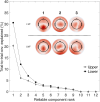Visual Field Asymmetries in Responses to ON and OFF Pathway Biasing Stimuli
- PMID: 39698978
- PMCID: PMC11730990
- DOI: 10.1017/S095252382400004X
Visual Field Asymmetries in Responses to ON and OFF Pathway Biasing Stimuli
Abstract
Recent reports suggest the ON and OFF pathways are differentially susceptible to selective vision loss in glaucoma. Thus, perimetric assessment of ON- and OFF-pathway function may serve as a useful diagnostic. However, this necessitates a developed understanding of normal ON/OFF pathway function around the visual field and as a function of input intensity. Here, using electroencephalography, we measured ON- and OFF-pathway biased contrast response functions in the upper and lower visual fields. Using the steady-state visually evoked potential paradigm, we flickered achromatic luminance probes according to a saw-tooth waveform, the fast phase of which biased responses towards the ON or OFF pathways. Neural responses from the upper and lower visual fields were simultaneously measured using frequency tagging - probes in the upper visual field modulated at 3.75 Hz, while those in the lower visual field modulated at 3 Hz. We find that responses to OFF/decrements are larger than ON/increments, especially in the lower visual field. In the lower visual field, both ON and OFF responses were well described by a sigmoidal non-linearity. In the upper visual field, the ON pathway function was very similar to that of the lower, but the OFF pathway function showed reduced saturation and more cross-subject variability. Overall, this demonstrates that the relationship between the ON and OFF pathways depends on the visual field location and contrast level, potentially reflective of natural scene statistics.
Keywords: ON/OFF pathways; luminance contrast; sawtooth stimuli; visual evoked potential; visual fields.
Figures








Similar articles
-
Measurements of long-range suppression in human opponent S-cone and achromatic luminance channels.J Vis. 2010 Nov 1;10(13):10. doi: 10.1167/10.13.10. J Vis. 2010. PMID: 21149312
-
Population encoding of spatial frequency, orientation, and color in macaque V1.J Neurophysiol. 1994 Nov;72(5):2151-66. doi: 10.1152/jn.1994.72.5.2151. J Neurophysiol. 1994. PMID: 7884450
-
Asymmetries of Dark and Bright Negative Afterimages Are Paralleled by Subcortical ON and OFF Poststimulus Responses.J Neurosci. 2017 Feb 22;37(8):1984-1996. doi: 10.1523/JNEUROSCI.2021-16.2017. Epub 2017 Jan 11. J Neurosci. 2017. PMID: 28077727 Free PMC article.
-
A few observations on linking VEP responses to the magno- and parvocellular systems by way of contrast-response functions.Int J Psychophysiol. 2014 Mar;91(3):147-54. doi: 10.1016/j.ijpsycho.2014.01.005. Epub 2014 Jan 15. Int J Psychophysiol. 2014. PMID: 24440598 Review.
-
Multifocal VEP and ganglion cell damage: applications and limitations for the study of glaucoma.Prog Retin Eye Res. 2003 Mar;22(2):201-51. doi: 10.1016/s1350-9462(02)00061-7. Prog Retin Eye Res. 2003. PMID: 12604058 Review.
Cited by
-
A machine learning model for predicting anatomical response to Anti-VEGF therapy in diabetic macular edema.Front Cell Dev Biol. 2025 May 30;13:1603958. doi: 10.3389/fcell.2025.1603958. eCollection 2025. Front Cell Dev Biol. 2025. PMID: 40519258 Free PMC article.
References
-
- Albrecht, D.G. & Hamilton, D.B. (1982). Striate cortex of monkey and cat: Contrast response function. Journal of Neurophysiology 48(Suppl. 1), 217–237. - PubMed
-
- Anderson, A.J. & Vingrys, A.J. (2000). Interactions between flicker thresholds and luminance pedestals. Vision Research 40(Suppl. 19), 2579–2588. - PubMed
Publication types
MeSH terms
Grants and funding
LinkOut - more resources
Full Text Sources
Miscellaneous

